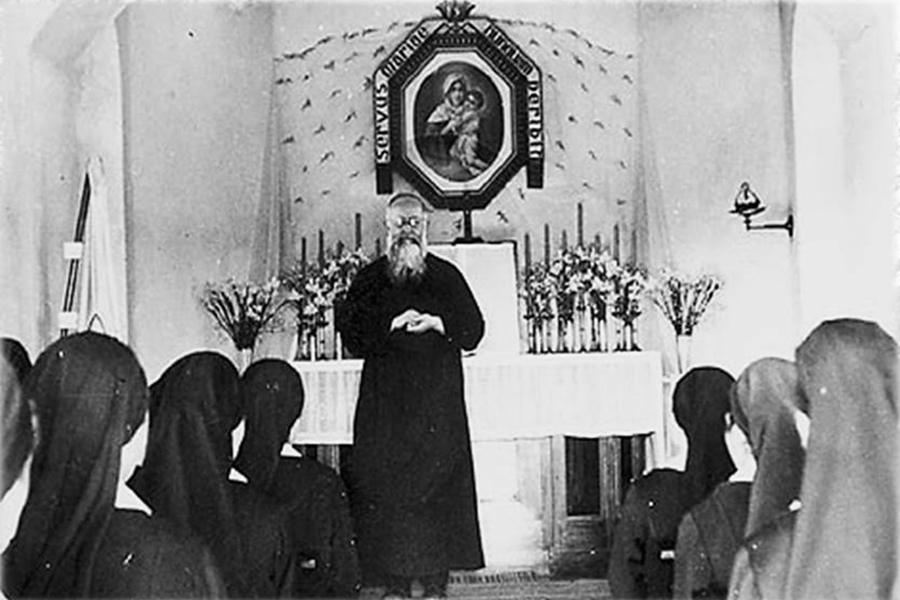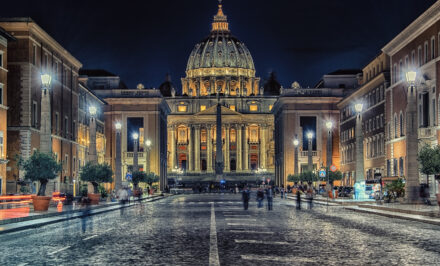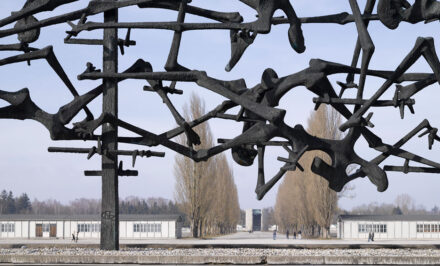Fr Elmar Busse, Germany •
We register Schoenstatt’s third milestone as having taken place on 31 May 1949, and localise it in Bellavista, Chile. It is the only milestone in Schoenstatt’s history that took place outside Europe. Nevertheless, I believe that it also has a great deal to do with Europe and Germany and dare to take a look at it from a German perspective of what happened and its message, which turns seventy this coming 31 May.—
The first and second milestones took place in Vallendar (18.10.1914) and Koblenz (20.1.42) in Germany, the fourth (22.10.1965) in the Vatican, Rome. The Schoenstatters in Chile, and the whole of Latin America, justifiably feel that the mission of the third milestone places them under an obligation to it. The high-risk act of the founder: to stake everything on one card and offer the Church Schoenstatt’s new, healing charism, and thus force her to grapple with overthrowing its usual and loved routines and structures – for its own salvation and mission. All this took place long before the Second Vatican Council, and, seen at close range, it all went horribly wrong. Not everyone is happy to have their ears boxed, even if it isn’t always a rebuke, but also serves to revive someone who has fainted, and gives expression to confirmation with the Holy Spirit.
Ears boxed in Bonn’s Parliament
When Beate Klarsfeld boxed the ears of the German Chancellor of that time, Kurt Georg Kiesinger, on 7 November 1968 in Bonn’s Parliament, it was a daring act. In 963 Beate Klarsfeld married the French lawyer and historian, Serge Klarsfeld, whose father had been a victim of the persecution of the Jews in Auschwitz. According to Beate Klarsfel, her husband helped her “to become a German with a conscience and awareness”. Through boxing the Chancellor’s ears in 1968 she started a process of more intensive confrontation with the Nazi past of many prominent people in Germany.
Only the worst criminals were investigated by the occupation powers. I once buried a former Nazi, a parishioner, in Berchtesgaden. His family knew about his past and were ashamed of him. That was why his funeral took place very privately. There were many such cases. The subject was somehow taboo. Only the discussion that followed the boxing of the Chancellor’s ears started a number of court cases against hangers-on who were also perpetrators – thirty years after the crimes were committed.
Fr Kentenich’s letter of 31 May – boxed ears; aimed at shaking things up
I would like to compare the ear boxing by Beate Klarsfeld with the letter Fr Kentenich wrote from Santiago, Chile, on 31 May 1949 to the Bishop of Trier. He wanted to provoke. He was not interested in a confrontation with crimes in the past that had been tabooed, but with highlighting a problem that was being ignored by the authorities in the Church, or not even seen as a problem. He wanted an intensive discussion of the problem he called “mechanistic thinking”. He saw very clearly that the Church in Germany and worldwide after the Second World War, could not just start again where she had been forced to stop in 1933.
His experience in Dachau. What had proved itself in extreme circumstances was suitable for daily use
As a prisoner in the concentration camp at Dachau, Fr Kentenich experienced that other prisoners who applied Schoenstatt’s spirituality were better able to deal with the inhuman conditions in the concentration camp. There were better able to protect themselves emotionally against the humiliations and chicanery, and they did not break down under their suffering. He rightly came to the conclusion that what had proved itself in extreme circumstances was suitable for coping with and forming everyday life in the strength of the faith. So, at the end of the war he visited many German bishops in order to introduce them to Schoenstatt’s spirituality, and to explain it more deeply. He secretly hoped that the German bishops would be behind Schoenstatt as a place of pilgrimage and take a stand to the spirituality that had grown there, rather as the Portuguese bishops had done at Fatima, even though such extraordinary miracles had not taken place in Schoenstatt as in Fatima.
Actually, it is quite correct, except for a few details
Auxiliary Bishop Dr Bernhard Stein therefore conducted a Visitation on behalf of the German Bishops’ Conference in February 1949. From 4-19 March Fr Kentenich, who was conducting retreats for priests in Argentina, wrote him letters – none under three pages long – in order to answer questions and misunderstandings. The Auxiliary Bishop did not address the questions directly to Fr Kentenich, but to Fr Menningen, who informed Fr Kentenich about what was happening. We need to remember that at that time letters took from two to three weeks to travel from Germany to Latin America. No one had thought of email or WhatsApp at the time.
On 27 February the Visitator gave an appreciative and benevolent talk in Schoenstatt. When Fr Kentenich received the long-expected official closing report of the Auxiliary Bishop, along with an accompanying letter, on 14 May 1949 – in the meantime he had travelled to Chile – it suddenly sounded quite different. Although Schoenstatt’s spirituality was judged to be dogmatically and theologically correct, the Bishop had many objections in the pedagogical field.
A major part of his criticism – this was only discovered years later – was based on calumnies by Sisters of Mary, including a former superior who had been replaced, which the Auxiliary Bishop accepted without examining them.
The risk
If Fr Kentenich had only been concerned about Schoenstatt, he could simply have taken note of the report and brushed aside the criticism as unimportant.
However, because the Auxiliary Bishops criticism revealed a mentality and mind-set that Fr Kentenich regarded as typical of the Catholic intelligentia of that time, and considered it the grave-digger of a vital spiritual life, he felt urged by the Holy Spirit to draw up a comprehensive study about the future pastoral strategy of the Church in Germany. He was well aware of the risk of what he was undertaking.
When the first part of his study was placed on the altar in the middle of the incomplete shrine at Bellavista on 31 May 1949, he told the few Sisters who were present, “We have to reckon with it that this work will deeply wound noble hearts in Germany, it will whip up a frenzy of outrage and give rise to powerful and sweeping counterattacks. We may not be surprised if a strongly united opposition of influential men will enter the arena against me and the Family. Humanly speaking, we must finally count upon it that this attempt will fail completely. Nevertheless, we may not consider ourselves dispensed from taking this daring step. Whoever has a mission has to carry it out, even if it leads to the darkest and deepest abyss, even if it requires one death leap after another. The lot of a prophet always includes the fate of a prophet.”
Dealing with mavericks
How right he was with his fears! In the years that followed he also had to justify himself to groups of Schoenstatters, explaining that he had not acted because of unwitting naivety, but that in starting this initiative he had been well aware of the risks. Many Pallottine Fathers, Schoenstatt Diocesan Priests, Sisters and laity painfully experienced a massive headwind. The academic discussion, and the conversation about pastoral strategy for the future style of pastorate in the Church in Germany, did not take place.
The objective conflict shifted to the level of relationships; then it only concerned power and influence. This “self-taught genius” (as the Visitator called him), who had not even studied psychology, was bringing a Trojan horse into the Church with his religious psychology! He had to be silenced!
That was the usual way with which authorities in the Church dealt with mavericks. We need only think of the fate of the Jesuit, Teilhard de Chardin.
“On account of his unorthodox theological opinions he came into conflict with the Congregation for the Doctrine of the Faith. He had already lost his professorship at the Institut catholique in 1926, and he spent the following twenty years in research, mainly in China.
He was no longer able to see the publication of his main work Le Phénomène Humain (The Phenomenon of Man) in 1940. According to the decision of his Order he was no longer allowed to publish any theological and philosophical works. Nevertheless, he was appointed a member of the French Académie des sciences in 1950. In 1951, as a result of the encyclical Humani generis, he was “banished” from France. He obeyed his Order’s discipline. He spent his last years as research associate in the American state of New York. When he died on Easter Sunday 1955 few followed his coffin at the funeral. Only after his death could his books be published and were very soon produced in vast numbers. His talks and secretly duplicated manuscripts had already awakened great interest.”[1]
What would have happened if …?
It needed the fresh wind of the Second Vatican Council to lead to the reinstatement of Fr Kentenich and his return to Schoenstatt (precisely on 24 December 1965). The eighty-year-old was able to devote himself to his communities and died on 15 September 1968. He was no longer able to witness the change of strategy in the pastorate, which he had so much hoped and inspired.
In view of the concerned question as to how things are to continue with the Church in Germany, let us try a little experiment.
What would the landscape of the Church look like today if the Archbishop of Trier had taken up Fr Kentenich’s suggestions, and, in addition to the usual means of passing on the faith in Germany through working in parishes and administering the sacraments, placed the emphasis on passing on experiences (because they address the heart directly), the formation of small groups (in which the stunted ability of many intellectuals to form relationships could have been developed and cultivated), as well as transferring the basic religious and liturgical expressions (praise, thanksgiving, petition, catechesis, interpreting life in the light of faith through exchange with one another) to the family?
From 1949-2019 we have lost seventy years of possible pastoral reform; and still today it is the case that many in authority believe that we only have to proclaim the truth more clearly, then a vital life of faith will automatically result.
Where is the mission of 31 May for Germany to be found? And elsewhere?
With its pastorate for accompanying families, as well as the academy for marriage and family pedagogy, the seven thousand Pilgrim Mother pictures visiting about seventy-thousand homes, the pastorate of home shrines, solid marriage preparation courses, an experience-oriented pastorate for young people, the Schoenstatt Movement in Germany can highlight many points – totally in keeping with Fr Kentenich’s objectives for the pastorate. However, in view of the 23 million Catholics in Germany they have more the character of pilot projects that are not always noticed by Church authorities or taken seriously. So, the impression is created that the provocation of 1949 was an effective cancer treatment that has simply not come onto the market.
In many countries Schoenstatt has today become a formative power for the pastorate and society, which comes close to Fr Kentenich’s daring hope in 1949. Think of Paraguay, where every third resident has come into contact with Schoenstatt through the Pilgrim Mother and the shrines, and where projects such as the School Book Publishers, advanced education for teachers out in the country, training and support for self-management initiatives, school equipment and early intervention for children on the margins of society, are known and valued all over the country; or else the pastoral projects such as the pastorate for divorced and re-married couples, which has been taken up by the Bishops’ Conference. Think of Costa Rica, with a university where Kentenich pedagogy is taught and Schoenstatters conduct pastoral initiatives in the parishes, often in collaboration with other Movements. Or in Burundi, where Schoenstatt has had a pioneering role in the peace process and is present in practice in all the country’s schools. Or Brazil, with huge Movements, such as, the Men’s Rosary and the Pilgrim Mother, that reach millions, and is an integral part of the entire pastoral work of the Church.
Nevertheless, in many countries it looks rather like Germany. What now?
[1] http://www.kathpedia.com/index.php/Teilhard_de_Chardin (english: M.Cole)
Original: German, 26/05/2019. Translation: Mary Cole, Manchester, UK

















“Not simply the great and the greater, but the greatest heights ought to be the object of our increased efforts.” Father Kentenich telephone. We must remember also that between the third and fourth milestone our founder spent his exile on the American Continent with visits from people of many nations throughout the world. Here he met with Family Members from many continents of the world. He suffered for a true unity he envisioned for his worldwide Schoenstatt Family and the Universal Church. “Dilexit Eclesium”
This is a very thought provoking reflection.
The challenge in the last line -hits home for me living in South Africa — does our Movement resemble Brazil or Costa Rica, or is it stunted like Germany?
I would say that a new rebirth is needed. The groups are important because they form the core of the Schoenstatt Movement. But we really cannot be focused only on our groups and preparing for our groups, and doing things for our groups.
Most people who encounter Schoenstatt don’t encounter groups or belong to groups. Instead, they remember fun events they attended as children (a rally day, a pilgrimage, a hike). They remember how a special day was prepared for their elderly family members (the Day for the Sick and Aged). A couple going through a difficult time in their marriage will remember a Marriage Camino they attended as they spoke through some important issues.These people will never join a group. But they will come to hte shrine. And they will encounter the Blessed Mother and the graces received from Christ in this place.
But they will only come if we create opportunities for them. That is how we build that wider movement that we read about in Brazil.
But we need to be clear. It’s not a numbers competition either. It’s about opportunities for transformation, one life, one person, one story at a time.